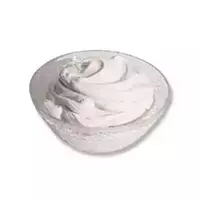Curd cheese

It is spread on bread, served to a salad of fresh vegetables, served with fruits, used as a filling for stuffed tomatoes or cannelloni, prepared on its basis a sauce for fish and meat. . . All this is about curd cheese, the possibilities of which in the culinary field are truly endless. True, it is important not to confuse the plant analogue with a natural dairy product.
Curd cheese is completely unlike its semi-hard and hard counterparts, which are distinguished by the presence of holes or mold. It is inherent in softness and tenderness, curd cheese is easily spread on bread, and in consistency it resembles homemade cottage cheese. Although, in fact, it is not far from the latter, since it also did not go through the ripening stage, unlike hard cheeses. Therefore, it can be said that curd cheese occupies an intermediate position between cheese and cottage cheese.
Curd cheese is made from cream or whole milk; the initial raw material is fermented with lactic acid starter cultures. In this regard, lactose is fermented and the finished cheese is almost safe for people who suffer from lactose intolerance.
In addition, this product contains a large amount of valuable protein of animal origin and other useful substances. So, in just 100 grams of this cheese, there is about 20 percent of the daily need for phosphorus and 10 percent for calcium. The calorie content of curd cheese is about 317 kcal per hundred grams, but this figure may vary depending on the presence of flavors in the product.
In order not to make a mistake in the choice when purchasing curd cheese, you must always carefully read what is written on the package. If the word cheese appears, then you have a natural dairy treat, while the inscription curd cheese product or cream cheese suggests that it is made on the basis of vegetable fats (in particular palm fats).
The list of components in the composition of curd cheese can also tell a lot. For example, the constituents of a natural product are cream (or milk), salt, and lactic acid starter. If preservatives are present in the composition, it is better to abandon such a product and look for curd cheese with a thermized prefix, which means that after undergoing thermal treatment, the product can be stored for up to four months.
If you're buying curd cheese to make a fruit dessert or sweet cake cream, it's best to opt for a pure creamy-flavoured product that features a crisp white colour and delicate consistency. Thanks to the rather high calorie content of curd cheese, dishes based on it will differ not only in tenderness, but also in increased nutrition.
For sandwiches or picnic sauce, a flavoured option would be a great option. There are a great many such cheeses on sale today - with herbs, salmon, seasonings, mushrooms. The main thing is that in the composition of such curd cheese there are not only flavors that imitate these ingredients, but also the products themselves - crushed greens, pieces of fish or mushrooms.
But no matter what version of curd dessert you prefer, the cheese should be homogeneous, soft, tender, without whey on the surface, and even more so mold. In this regard, before putting a jar of appetising content in the basket, check its integrity and see if the product has expired.
317 kCal curd cheese
Energy value of curd cheese (Ratio of proteins, fats, carbohydrates - ju):
Proteins: 7 g (~ 28 kCal)
Fats: 31 g (~ 279 kCal)
Carbohydrates: 2.5 g (~ 10 kCal)
Energy ratio (bj | y): 9% | 88% | 3%
 Español
Español Français
Français Português
Português Русский
Русский 简体中文
简体中文 繁體中文
繁體中文 日本語
日本語 한국어
한국어 العربية
العربية Türkçe
Türkçe Қазақ
Қазақ Deutsch
Deutsch Italiano
Italiano Українська
Українська
